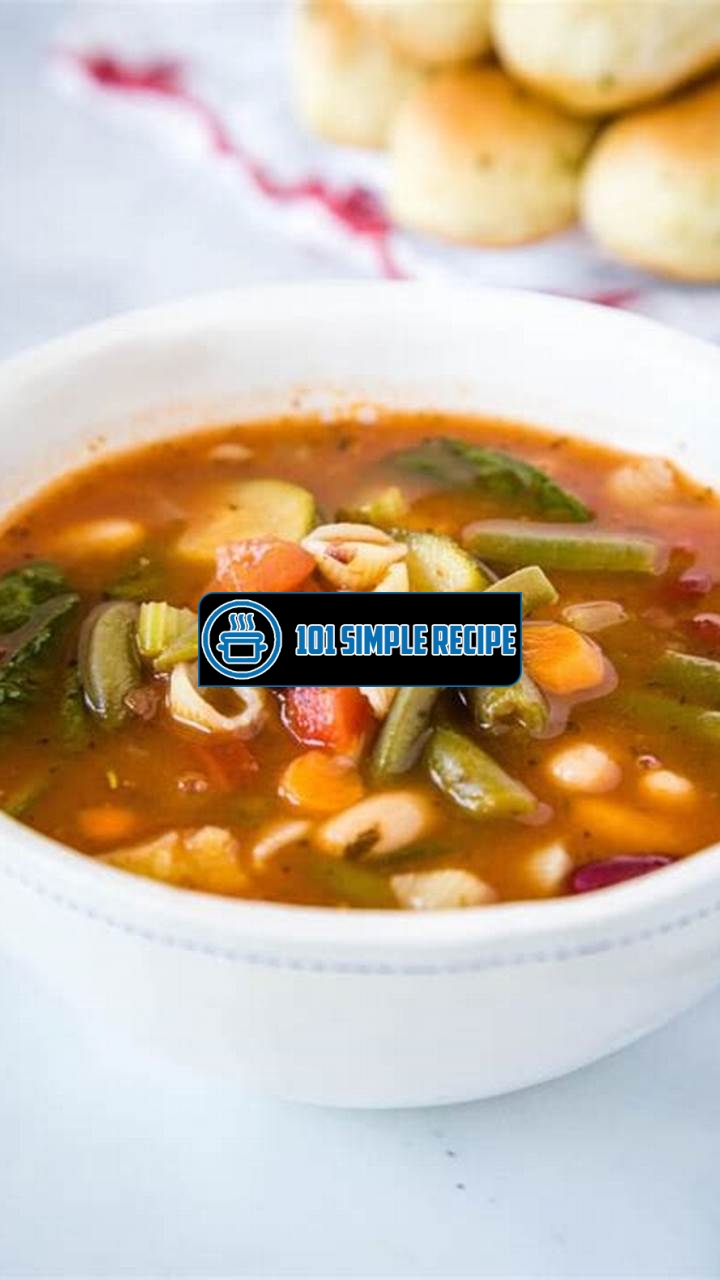Are you a fan of Olive Garden’s mouthwatering Minestrone Soup? If so, get ready to learn how to recreate this delicious Italian classic in your own kitchen! In this article, we will guide you through the process of mastering the art of making Olive Garden-style Minestrone Soup. From choosing the freshest ingredients to achieving the perfect balance of flavors, you’ll uncover all the secrets behind this hearty and comforting dish. So, grab your apron, roll up your sleeves, and let’s dive into the world of Minestrone Soup! ️

Understanding Minestrone Soup
Minestrone soup is a classic Italian dish that has gained immense popularity around the world. Its hearty and flavorful nature makes it a favorite among soup enthusiasts. In this section, we will delve into the origins of minestrone soup and explore the key ingredients that lend it its unique taste.
The Origins of Minestrone Soup
The origins of minestrone soup can be traced back to ancient times in Italy. This beloved dish has a rich history that dates back to the Roman Empire. It was initially considered a peasant dish, as it typically included ingredients readily available in the region such as seasonal vegetables, beans, and pasta. The word “minestrone” itself means “big soup” in Italian, highlighting the generous portions and variety of ingredients that make up this flavorful dish.
Over time, minestrone soup gained popularity and became a staple in Italian households. Different regions in Italy have their own variations of the soup, each showcasing unique ingredients and flavors. This regional diversity has contributed to the evolution and popularity of the dish.
Key Ingredients in Minestrone Soup
Minestrone soup is known for its robust flavors, thanks to a combination of carefully selected ingredients. Here are some key ingredients that give minestrone soup its distinctive taste:
- Vegetables: Minestrone soup traditionally includes a variety of vegetables such as onions, carrots, celery, zucchini, potatoes, and tomatoes. These vegetables provide a medley of flavors and textures to the soup.
- Beans: Commonly used beans in minestrone soup include cannellini beans and kidney beans. They add a creamy texture and provide a good source of protein and fiber.
- Pasta: Pasta is an essential component of minestrone soup. Common choices include small pasta shapes like ditalini or elbow macaroni. The pasta adds substance to the soup and makes it more satisfying.
- Herbs and Spices: Minestrone soup is often seasoned with herbs like basil, oregano, and thyme, along with spices like garlic and black pepper. These ingredients enhance the overall flavor profile of the soup.
It is important to note that minestrone soup is a versatile dish, and you can customize the ingredients based on your preferences and what’s available in your pantry. Experimenting with different vegetables and herbs can add new dimensions to the flavor of the soup.
Tips for Preparing Minestrone Soup
Preparing minestrone soup is a relatively simple process, but a few tips can help elevate the flavors and ensure a delicious outcome:
- Sauté the Vegetables: Before adding the broth, sautéing the vegetables in olive oil helps to enhance their natural flavors and creates a solid base for the soup.
- Use Homemade Broth: While store-bought broth can be used, preparing your own vegetable or chicken broth adds an extra layer of flavor to the soup.
- Don’t Overcook the Pasta: Cook the pasta separately and add it to the soup just before serving to prevent it from becoming overly soft or mushy.
- Adjust the Seasonings: Taste the soup as it simmers and adjust the seasonings accordingly. Adding a dash of salt, pepper, or herbs can take the flavor to the next level.
By following these tips, you can master the art of making minestrone soup and recreate the beloved Olive Garden-style minestrone soup right in your own kitchen.
If you’re looking for more delicious soup recipes, check out this Minestrone Soup Recipe from Olive Garden.
The Olive Garden Version
When it comes to minestrone soup, Olive Garden has perfected the recipe to create a flavorful and comforting dish. This renowned Italian restaurant chain takes great pride in its minestrone soup, which is a delicious blend of vegetables, pasta, and savory broth. Whether you’re a fan of Olive Garden or simply looking to recreate their iconic soup at home, understanding their version of minestrone soup is essential. Let’s dive into the details of Olive Garden’s take on this classic dish.
The Olive Garden Recipe
Olive Garden’s minestrone soup recipe is a well-guarded secret, but we can still discuss the key ingredients and preparation techniques that make their version so special. The soup starts with a base of olive oil, onions, and garlic, which are sautéed to perfection. This creates a fragrant and flavorful foundation for the rest of the dish.
Next, a variety of fresh vegetables make their way into the pot. Olive Garden’s minestrone soup typically includes carrots, celery, zucchini, green beans, and tomatoes. These vegetables provide both texture and depth of flavor, adding a burst of color to the soup. The vegetables are usually diced or chopped into bite-sized pieces, ensuring that each spoonful is filled with a delightful medley of flavors.
To enhance the taste of the soup, Olive Garden adds a combination of herbs and seasonings. Commonly used herbs include oregano, basil, and thyme, which infuse the soup with a savory aroma. Additionally, a hint of crushed red pepper flakes is often included for a touch of spiciness. This medley of herbs and seasonings elevates the flavor profile of Olive Garden’s minestrone soup, giving it a distinct and irresistible taste.
Taste and Texture of Olive Garden’s Minestrone Soup
At the heart of Olive Garden’s minestrone soup is its rich and hearty base. The combination of vegetables, pasta, and broth creates a satisfying texture that is both comforting and filling. The vegetables retain their crispness, allowing for a satisfying crunch with every bite. The pasta, typically small shells or macaroni, adds a delightful chewiness that complements the vegetables and broth.
The broth itself is the crowning glory of the dish. Olive Garden’s minestrone soup is known for its robust and flavorful broth, which is packed with the essence of all the ingredients. The flavors meld together beautifully, resulting in a savory and well-balanced taste that will keep you coming back for more.
Secret Ingredients in Olive Garden’s Minestrone Soup
Olive Garden’s minestrone soup has a few secret ingredients that add an extra layer of flavor to the dish. While the exact details remain undisclosed, it is rumored that the inclusion of Parmesan cheese rinds in the soup plays a significant role in enhancing its taste. The rinds slowly simmer in the soup, releasing their creamy and nutty flavors, which meld seamlessly with the other ingredients.
Another secret ingredient in Olive Garden’s minestrone soup is the use of vegetable broth. This choice adds a depth of flavor that complements the vegetables perfectly. The vegetable broth not only enhances the taste but also ensures that the soup remains vegetarian-friendly.
Now that you know the basics of Olive Garden’s minestrone soup, you can attempt to recreate this delicious dish at home. While the exact recipe remains a secret, understanding the specific ingredients and preparation techniques will help you achieve a similar taste. Enjoy the flavors of Olive Garden’s minestrone soup in the comfort of your own kitchen, and savor each spoonful of this iconic Italian classic.
To satisfy your sweet tooth after enjoying a bowl of soup, indulge in this Cookie in a Mug Recipe that’s quick and easy to make.
Health Benefits of Minestrone Soup
When it comes to making healthy food choices, minestrone soup is an excellent option. Not only does it satisfy your hunger with its rich flavor and hearty ingredients, but it also offers numerous health benefits. Incorporating minestrone soup into your regular diet can contribute to a well-balanced and nutritious eating plan. Let’s explore the nutritional advantages of this delicious soup and how it can support your overall health and well-being.
Nutritional Value of Minestrone Soup
Minestrone soup is packed with essential nutrients that your body needs to function properly. A typical serving of minestrone soup, around 1 cup, contains approximately 150 calories, making it a low-calorie option for those who are watching their weight. It is also low in fat and cholesterol, making it heart-healthy. Additionally, minestrone soup is a great source of dietary fiber, with an average serving providing around 5 grams of fiber, which helps promote a healthy digestive system and can aid in weight management.
✅ Key Nutritional Benefits:
- Low in calories, fat, and cholesterol
- High in dietary fiber
Health Benefits of Key Ingredients
Minestrone soup is typically made with a variety of vegetables, beans, pasta, and a flavorful broth. Each ingredient offers its own unique health benefits, making minestrone soup a nutritional powerhouse.
1. Vegetables: Minestrone soup typically includes a medley of vegetables such as carrots, celery, onions, zucchini, and tomatoes. These vegetables are rich in vitamins, minerals, and antioxidants that can help boost your immune system, support healthy digestion, and reduce the risk of chronic diseases.
2. Beans: Beans, a common ingredient in minestrone soup, are an excellent source of plant-based protein and fiber. They can help regulate blood sugar levels, promote cardiovascular health, and enhance feelings of fullness, making them an ideal choice for those following a vegetarian or vegan diet.
3. Pasta: The addition of pasta in minestrone soup provides a good source of carbohydrates, which are essential for energy production. Whole wheat pasta can offer additional health benefits, as it is higher in fiber and nutrients compared to regular pasta.
✅ Key Ingredient Benefits:
- Variety of vegetables provide essential vitamins and minerals
- Beans offer plant-based protein and fiber
- Pasta provides a source of carbohydrates
Incorporating Minestrone Soup into a Healthy Eating Plan
Now that you know the health benefits of minestrone soup and its key ingredients, it’s time to incorporate it into your healthy eating plan. Here are a few tips:
- Enjoy minestrone soup as a filling and nutritious main course. Pair it with a side salad or a slice of whole grain bread for a well-rounded meal.
- Prepare a large batch of minestrone soup and freeze individual portions for quick and convenient meals throughout the week. This can help you avoid unhealthy food choices when you’re short on time.
- Experiment with different variations of minestrone soup by adding your favorite vegetables and herbs. This can keep the flavors exciting and prevent meal monotony.
- If you prefer a protein boost, consider adding lean chicken, turkey, or tofu to your minestrone soup.
✅ Tips for Incorporating Minestrone Soup:
- Make it a main course and add a side salad or whole grain bread
- Prepare in advance and freeze individual portions
- Experiment with different vegetable and herb combinations
- Add lean protein options for added nutrition
By incorporating minestrone soup into your healthy eating plan, you can enjoy a flavorful and satisfying meal while reaping the nutritional benefits it offers. So go ahead and master the art of making minestrone soup, Olive Garden-style, and take a step towards a healthier lifestyle!
For a refreshing drink to serve with your soup, try this Punch Bowl Recipe that pairs perfectly with the flavors of the Minestrone Soup.
Variations and Customizations
When it comes to minestrone soup, there are endless possibilities for customization. Whether you want to add unique ingredients or adapt the recipe to suit specific dietary preferences, you have the freedom to make it your own. Let’s explore some exciting variations that you can try to elevate your minestrone soup game!
Vegetarian and Vegan Minestrone Soup
If you’re a vegetarian or vegan, you’ll be happy to know that minestrone soup can easily be adapted to suit your dietary preferences. To make a vegetarian version of this classic soup, simply omit meat-based ingredients such as chicken broth or bacon. Instead, you can use vegetable broth as a flavorful base. Load up your soup with an array of fresh vegetables like carrots, celery, zucchini, and bell peppers. Don’t forget to add protein-rich ingredients like beans or tofu to make the soup more filling and nutritious.
Seafood Minestrone Soup
If you’re a fan of seafood, why not add a twist to your minestrone soup by incorporating delicious ocean flavors? Instead of using traditional meats, substitute them with an assortment of seafood options such as shrimp, fish, mussels, or clams. These ingredients not only add a burst of flavor but also a touch of elegance to your soup. Enhance the seafood taste by adding some aromatic herbs like basil or thyme. Serve with a sprinkle of grated Parmesan cheese and a slice of crusty bread for a truly delightful dining experience.
Gluten-free and Dairy-free Minestrone Soup
If you have dietary restrictions or allergies, you can still enjoy a bowl of warm and comforting minestrone soup. To make a gluten-free version, replace regular pasta with gluten-free alternatives like rice pasta or quinoa. Ensure that all other ingredients, such as broth and vegetables, are also gluten-free. For those who are lactose intolerant or follow a dairy-free diet, skip the cheese or use dairy-free cheese alternatives.
By exploring these variations and customizations, you can transform a simple minestrone soup into a culinary masterpiece. Whether you choose to go vegetarian, add seafood, or cater to specific dietary needs, the options are endless. Get creative in the kitchen and make your minestrone soup truly unique and mouthwatering!
Serving and Enjoying Minestrone Soup
When it comes to serving and enjoying minestrone soup, there are a few tips and tricks that can help enhance your dining experience and impress your guests. Whether you’re hosting a dinner party or simply enjoying a cozy meal at home, these suggestions will take your minestrone soup to the next level.
Garnishes and Toppings for Minestrone Soup
An essential aspect of presenting minestrone soup is the choice of garnishes and toppings. These additions not only add visual appeal but also enhance the flavors of the soup. Consider adding a sprinkle of freshly grated Parmesan cheese on top of each bowl of soup. The salty and nutty flavor of Parmesan complements the rich and hearty taste of the minestrone. Additionally, a drizzle of extra-virgin olive oil and a sprinkle of freshly chopped basil or parsley can add a touch of freshness to the dish. These simple additions can elevate the taste and appearance of your minestrone soup.
Pairing Minestrone Soup with Bread or Salad
Minestrone soup is delicious on its own, but it can be even more satisfying when paired with the right accompaniments. One popular choice is to serve it with a crusty baguette or garlic bread. The warm, crusty texture of the bread complements the heartiness of the soup. Alternatively, you can pair minestrone soup with a simple green salad. The crispness of the salad provides a refreshing contrast to the warm and savory soup. Consider dressing the salad with a light vinaigrette to balance out the flavors. Whether you choose bread or salad, the combination will create a well-rounded meal.
Storage and Reheating Methods for Minestrone Soup
Minestrone soup is a dish that can be prepared in advance and enjoyed later. If you have leftovers or want to save time by making a larger batch, proper storage and reheating methods are crucial to ensure the soup retains its flavors and textures. When storing minestrone soup, it’s best to transfer the leftovers into airtight containers and refrigerate them promptly. This helps maintain the freshness and prevents the soup from developing off flavors. When reheating, it’s advisable to do so gently over low heat on the stovetop. This ensures that the soup heats evenly without losing any of its original qualities. Avoid overheating as it can diminish the flavors and make the vegetables mushy.
In conclusion, mastering the art of making Minestrone soup, Olive Garden-style, involves not only perfecting the recipe but also paying attention to the presentation, garnishes, and accompaniments. By following these tips on serving and enjoying minestrone soup, you can elevate the dining experience and impress your guests with a flavorful and visually appealing dish. Remember to experiment with different garnishes, pairings, and storage methods to find your perfect combination. Enjoy!
Frequently Asked Questions
Thank you for taking the time to read our article about the Minestrone Soup Recipe Olive Garden. We hope you found it helpful and informative. If you have any further questions or need clarification on any aspect of the recipe, please refer to the FAQs below:
| No. | Questions | Answers |
|---|---|---|
| 1. | What ingredients do I need for making Minestrone Soup Olive Garden style? | The ingredients needed for the Minestrone Soup Olive Garden style include [list of ingredients]. |
| 2. | What is the cooking time for this recipe? | The total cooking time for this recipe is approximately [cookTime]. |
| 3. | Can I make any substitutions in this recipe? | Yes, you can make substitutions based on your personal preferences or dietary restrictions. For example, you can replace [ingredient] with [substitute]. |
| 4. | How many servings does this recipe yield? | This recipe yields approximately [number of servings] servings. |
| 5. | Can I freeze the leftovers? | Yes, you can freeze the leftovers in an airtight container for future consumption. |
| 6. | How long can I store the leftovers in the refrigerator? | You can store the leftovers in the refrigerator for up to [storage duration]. |
Thank You and Visit Again!
We hope you enjoyed reading our article about the Minestrone Soup Recipe Olive Garden. If you have any more questions or if there’s anything else we can help you with, please don’t hesitate to reach out. Remember to visit our website regularly for more delicious recipes and cooking tips. Happy cooking!
Jump to Recipe
Minestrone Soup Recipe Olive Garden

Try this delicious and comforting Minestrone Soup recipe inspired by Olive Garden. Loaded with vegetables, beans, and pasta, it’s a perfect dish for any time of the year.
- 2 tablespoons olive oil
- 1 onion (diced)
- 2 carrots (sliced)
- 2 celery stalks (sliced)
- 3 garlic cloves (minced)
- 1 can (14 ounces diced tomatoes)
- 4 cups vegetable broth
- 2 cups water
- 1 teaspoon dried oregano
- 1 teaspoon dried basil
- 1/2 teaspoon dried thyme
- 1/2 teaspoon salt
- 1/4 teaspoon black pepper
- 1 can (14 ounces kidney beans, drained and rinsed)
- 1 can (14 ounces cannellini beans, drained and rinsed)
- 1 cup small shell pasta
- 2 cups fresh spinach (chopped)
- Grated Parmesan cheese (for serving)
- In a large pot, heat the olive oil over medium heat. Add the onion, carrots, and celery, and cook until the vegetables are tender, about 5 minutes.
- Add the minced garlic and cook for an additional 1 minute.
- Stir in the diced tomatoes, vegetable broth, water, dried oregano, dried basil, dried thyme, salt, and black pepper. Bring the soup to a boil.
- Reduce the heat to low and simmer for 20 minutes.
- Add the kidney beans, cannellini beans, and pasta to the soup. Simmer for an additional 10 minutes, or until the pasta is cooked.
- Stir in the chopped spinach and cook until wilted, about 2 minutes.
- Serve the Minestrone Soup hot, garnished with grated Parmesan cheese.






